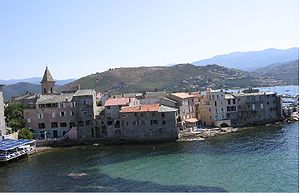Patrimonio (wine region)
The Patrimonio wine-growing region is an appellation named after the place of the same name in the north of the island of Corsica . Since October 23, 1984 (the decree was last revised on August 29, 2002) the area has the status of an Appellation d'Origine Contrôlée (AOC for short). Approved vineyards are spread across the seven municipalities of Barbaggio , Farinole , Oletta , Patrimonio , Poggio-d'Oletta , Saint-Florent and Santo-Pietro-di-Tenda . This area therefore partially overlaps with the Muscat du Cap Corse appellation . Approx. 13,800 hl of wine are harvested on a vineyard area of approx. 420 hectares (as of 2002). The lion's share of this is red and rosé wines; only 1,800 hl are white wine. The climate in combination with the barren soils and the hillside location of the vineyards allows only a very limited yield and thus ensures a good quality of the berry material. The long-term average is a very low yield of 34.25 hl / ha.
geography
The cultivation area extends in a semi-circular shape on slight slopes around the Gulf of Saint-Florent, just a few kilometers west of the city of Bastia . In the west the area extends to the Agriaten desert. ( Désert des Agriates ). Viticulture is mainly concentrated around the municipalities of Patrimonio, Farinole and Barbaggio. The vineyards are no higher than 50 meters above sea level . The heart of the area has a limestone - clay soil on a limestone base. The Niellucio grape variety finds ideal conditions on this soil, which is covered with beautiful pebbles, and produces powerful, tannic wines. In the western area near the Désert des Agriates, a clay soil with weathered granite on a granite plinth predominates .
climate
The area to the north is exposed to the frequently blowing, sometimes violent winds from the north-east. In times of damp weather, the wind dries the berries and in this way ensures healthy grapes. During the summer drought, however, there is often no wind, so moist maritime air alleviates the water shortage somewhat. During the night, colder air sinks from the up to 1000 m high mountains south of the appellation and thus ensures a balanced wine-growing climate with a slightly delayed growth period.
The wines
- The red wines have consisted of at least 90% Sangiovese since the 2000 vintage, which is called Nielluccio in Corsica. The secondary varieties Grenache , Sciaccarello and / or the white Vermentino variety may be used for the remaining 10% . The Most must before fermentation for at least 189 g / l sugar have. The dry red wine has an alcohol content of at least 12% by volume.
- the rosé wine is made from the same grape varieties as the red wine. Here, however, the required minimum proportion of Nielluccio is 75%. Before fermentation, the must must have at least 170 g / l sugar. The dry rosé wine has an alcohol content of at least 11% by volume.
- Since 2000, the white wine has been made from the Vermentino grape variety , locally known as Vermentinu or Malvoisie de Corse . Before fermentation, the must must have at least 170 g / l sugar. The dry rosé wine has an alcohol content of at least 11% by volume.
As a specialty of sorts Greanche and is very late harvested berries Aleatico the rappu made a red naturally sweet dessert wine . However, the quantities produced are very modest.
The white wine can be stored for about 2–3 years, but does not gain from storage. It should be enjoyed at a drinking temperature of 8 to 10 ° C. The same applies to the rosé.
The red wine, on the other hand, should be stored for 3–5 years. The drinking temperature is 15-16 ° C.
See also
literature
- Jancis Robinson: The Oxford Wine Lexicon . Gräfe and Unzer Verlag, Munich 2003, ISBN 3-7742-0914-6 .
- Pierre Galet: Cépages et Vignobles de France . Lavoisier Publishing House, Paris 2004, ISBN 2-7430-0585-8 .
- Benoît France: Grand Atlas des Vignobles de France . Éditions SOLAR publishing house, Paris 2002, ISBN 2-263-03242-8 .

